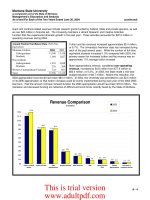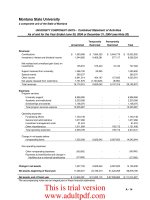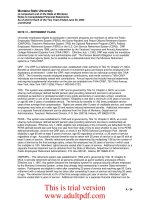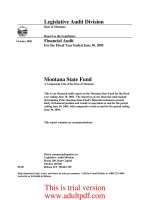Legislative Audit Division State of Montana Report to the Legislature December 2006 Financial_part8 doc
Bạn đang xem bản rút gọn của tài liệu. Xem và tải ngay bản đầy đủ của tài liệu tại đây (695.49 KB, 9 trang )
Montana State University
Unaudited Supplemental Information
June
30,2006
(continued)
MSU Extension Sewice
Agency Overview
The mission of the Montana State University Extension Service is to extend the positive impact of research-generated
knowledge throughout the state by making it accessible and useful to individuals, families and communities,
empowering them to improve their quality of life and strengthen agriculture, forestry and other businesses. To meet the
educational needs of Montanans, Extension coordinates all appropriate educational and research resources in the region
through campus-based specialists and county and reservation agents.
The unique funding structure of the Extension Service includes State general fund, Federal Smith-Lever and county
sources. The State legislature appropriates both State general funds and Federal Smith-Lever funds on a biennial basis.
Extension agent salaries are paid from Federal Smith-Lever and county funding sources. Extension specialists are paid
from State general funds. Extension funds 100 percent of the benefit costs for all employees hired on current
unrestricted funding from a blend of Federal Smith-Lever and State general fund dollars. Operational allocations are
made to specialists based on a pre-established formula. Other operating dollars are allocated to support staff
development, program development, personnel recruitment and general operating purposes.
While 12,000 students further their education on the MSU campus each year, through Extension, MSU reaches out to all
of the citizens of Montana. MSU Extension has 35 campus-based specialists and 62 offices across the state serving all
56 counties and five reservations. In addition, seven Tribal College agent offices are affiliated with Extension. Because
Montana's communities are as diverse
as
its landscape, the very structure of our organization MSU faculty living in
Montana's small towns and cities ensures that programs are in tune with local issues and can adapt quickly to changing
needs.
To deliver the practical advice and information needed by Montana's agricultural community, Extension taps into the
resources of the entire university system. Research results from the Ag Experiment Station and programs like the
Montana Beef Network and Sheep Institute, as well as the U.S.D.A., assist in developing programmatic responses.
Primary
concerns related to sustainability and profitability, natural resources and the environment, and technology
transferlvalue-added opportunities are addressed through outreach efforts across the state.
Extension's Family
&
Consumer Sciences program area serves people and families of all shapes and sizes from the
elderly to kids, from single parents to stepfamilies. Topics include food and nutrition, housing, health, family issues,
personal finance, environmental health and many other subjects useful to Montanans. A special program emphasizes
nutrition education for families with limited resources.
Montana 4-H annually reaches over 22,000 Montana youth, ages 6-19. About 40 percent of these youth are involved
in
year-long community clubs, while the rest are active through a variety of short term and special interest education
programs. These youth are supported by nearly 4,000 trained adult and youth volunteers who lead local programs and
activities.
Tourism development continues to be an area of major emphasis for Extension's Community Development program.
Extension continues to collaborate with a variety of state and federal agencies to provide tourism development
education for local communities and individuals. Over the next two years Extension will expand on its partnership with
the Northwest Area Foundation to develop poverty reduction programs in 25
nual Montana communities.
The strategic plan for Extension outlines strategies and action plans for meeting the challenge of helping Montana
families and communities thrive through practical application of research-based information. It is based on the
integration of extensive input and advice from Montana citizens, advisory boards and Extension personnel. Working
groups of Extension staff, an overall planning committee and the Montana Extension Advisory Council chart annual
progress in achieving the goals and objectives for each major issue identified in the plan.
This is trial version
www.adultpdf.com
Montana State University
Unaudited Supplemental Information
June
30,2006
(continued)
Fire Services Training School
Agency Overview
The Fire Services Training School (FSTS) is an educational outreach program of Montana State University's Extension
Service. The mission of FSTS is to build capacity in local governments for protecting citizens' lives and property, and
safeguarding the community tax base and infrastructure from harm caused by
fires, accidents, injuries, hazardous
materials incidents and other emergencies. The FSTS is authorized in 20-31-102, MCA, and its office is located at 750
6" Street Southwest, Great Falls; however, trainers who provide instruction and resources to local fire and rescue
services are strategically located around the state.
Emergencies strike Montana communities every day. In an emergency, the members of local government fire and
rescue services are among the first line of defense, and the first help to arrive at the scene. The FSTS audience consists
of 11,000 fire fighters, 96 percent of whom are volunteers, statewide. The Fire Services Training School provides 75
percent of its services to volunteer fire fighters and 25 percent to career fire fighters.
The FSTS curriculum includes entry level recruit academies, hazardous materials and technical rescue courses,
leadership and management, as well as tactical and strategic level incident operations courses.
The Fire Services Training School has been primarily responsible for introducing new technology into local emergency
forces. Rural Water Shuttles, Training-in-Context, Compressed Air Foam Systems, Positive Pressure Ventilation and
Incident Management Systems have all been introduced by FSTS and adopted by community responders, resulting in
safer and more efficient operations. Involvement with FSTS has resulted in significantly reduced costs for fire insurance
premium payers in many communities.
When citizens require emergency help, they dial 91 1; when providers of that emergency help need assistance, they call
the Fire Services Training School. In the 2006 fiscal year, 3,618 emergency responders from 54 counties received
26,592 hours of instruction from FSTS. The school issued a total of 45 professional training certifications and made
1,060 resource center loans of equipment and training materials.
This is trial version
www.adultpdf.com
Montana State University
Unaudited Supplemental Information
June
30,2006
(continued)
MSU-
Billings
Campus
Overview
MSU-Billings is a comprehensive public four-year higher education institution located in Montana's largest population
center, whose faculty is actively engaged in teaching, research, creative endeavors and public service. The University
opened in
1927
and was initially called Eastern Montana State Normal School at Billings and was established to prepare
teachers for elementary schools in eastern Montana. MSU-Billings has grown, with the city of Billings and
Yellowstone County, into the major higher education center of south central Montana. The University consists of six
colleges: the College of
Arts
and Sciences, the College of Business, the College of Education, the College of
Professional Studies and Lifelong Learning, the College of Technology, and the College of Allied Health Professions.
MSU-Billings offers a fill complement of one and two year certificate programs, associate degrees, and bachelor and
master degrees, as well as pre-professional academic offerings in a number of fields. Several academic programs are
unique to the Montana University System.
MSU-Billings is accredited by the Northwest Association of Schools and Colleges. It is accredited by the National
Council for the Accreditation of Teacher Education for preparing elementary and secondary teachers and school
counselors through the Bachelor of Science and Master of Education degrees and the Master of Science in Special
Education degree. MSU-Billings is also accredited by the National Association of Schools of Music, the National
Association of Schools of Art and Design, and the Council on Rehabilitation Education. College of Technology
programs are approved by the National Institute for Automotive Service Excellence, the National Automotive
Technicians Education Foundation, the Montana Board of Nursing, and the Commission on Accreditation of Allied
Health Education Programs. MSU-Billings has achieved candidacy status for Association to Advance Collegiate
Schools of Business accreditation for its College of Business.
Public service is integral to the mission of the University. Its two primary public service entities are Yellowstone Public
Radio and the Montana Center on Disabilities, a comprehensive education, rehabilitation, and diagnostic center serving
Montanans with disabilities.
Annual Student FTE for Fiscal Years Ended June
30,
2006 2005 2004 2003 2002
Resident
Undergraduate
College of Technology
Graduate
Total Resident
Non-resident
Undergraduate
College of Technology
Graduate
Total non-resident
Western Undergraduate Exchange
Main Campus
225
189 169 146 165
College of Technology
26 18 14 15
12
Total Western Undergraduate
Exchange 25
1
207 183 161 177
Total
4,219 4,151 4,163 3,962 3,920
This is trial version
www.adultpdf.com
Montana State University
Unaudited Supplemental Information
June
30,2006
(continued)
Degrees Granted
-
Fiscal Years Ended June
30,
2006 2005 2004 2003 2002
College of Technology 186
183
185 169 146
Undergraduate 524 525
5
17 519 513
Graduate 99 115 136
103
107
Total
809 823 83 8 791 766
MSU-Billings has made a substantial investment in distance learning by developing full degree programs, and general
education, online. This investment will continue in order to provide educational offerings to Montana citizens who are
place bound or time bound. Increasing opportunities for students to participate in internships and cooperative education
experiences continues to be a high priority for the University. Additional funds have been allocated to increase the
number of supervised internships and cooperative experiences available to students in all disciplines.
Campus Outlook
MSU-Billings continues to serve our students and community with superior levels of excellence.
The University's downtown Billings campus facilities were expanded to house the College of Professional Studies and
Lifelong Learning, to assist with the development of downtown Billings and to serve the educational needs of the area's
employees and businesses. The downtown campus plays a key role in community-wide work force development and
training.
Because Billings is the primary health care center of the region, MSU-Billings partnered with the health care industry to
meet its educational needs and established the College of Allied Health Professions with key programs in athletic
training, health and human performance and rehabilitation and human services.
MSU-Billings opened an office in Red Lodge, Montana as part of an ongoing initiative to reach out into the
communities the University serves. The office will also assist students and prospective students with academic and
admissions information.
For the seventh consecutive year, MSU-Billings has been ranked as one of the nation's 'Best Colleges' by
U.S.
News
and World Report, for undergraduate through master's level academics, in the latest edition of "America's Best
Colleges
2006".
The College of Technology has continued its transition to a true community college by expanding offerings and
programs. Enrollment growth has been significant at the MSU-Billings College of Technology. With the College of
Technology focusing on the needs of two-year education in the Billings region, it is anticipated that the growth in
enrollment will continue. A new
$9
million state-of-the-art academic facility at the College of Technology was
approved by the
2005 Legislature and is expected to be completed in time for classes in fall of 2007. The Board of
Regents Workforce Development Committee allocated over
$1
million in equipment funds to the College of
Technology. A new Construction Trades Training Program was developed in
2005 in partnership with the Montana
Contractors' Association, Inc.
MSU-Billings is increasing its academic offerings by initiating the following programs: Bachelor of Science in
Criminal Justice; Bachelor of Science in Business Administration with a General Business On-line Option; Bachelor of
Science in General Science with a Teaching Option; a double major of Bachelors of Education and Reading; a
Sociology Teaching Option; and an Associate of Applied Science in Computer Programming and Application
Development.
The People, Pride
&
Promise Campaign for Excellence at Montana State University
-
Billings is a five-year effort with
an initial goal to raise
$21 million for scholarships, academic programs, faculty and facilities. Over
$23
million in gifts
and pledges has been raised to date.
This is trial version
www.adultpdf.com
Montana State University
Unaudited Supplemental Information
June
30,2006
(continued)
MSU- Northern
Campus
Overview
Established by the Legislative Assembly of the State of Montana in 1913, "The Northern Montana Agricultural and
Manual Training School" opened in 1929 under the name "The Northern Montana School." In 193
1,
the common use
of "Northern Montana College" came into existence. In 1994, Northern Montana College became Montana State
University-Northern (MSU-Northern) as part of the restructuring with Montana State University in Bozeman.
Montana State University-Northern offers programs of professional preparation emphasizing discipline mastery, critical
inquiry, and social responsibility in:
teacher preparation
mechanical and engineering technologies
business and computer information systems
nursing
arts and sciences
MSU-Northern applies emerging technologies in degree programs ranging from the certificate to master's level. MSU-
Northern produces well-educated students who are capable of decisive action and application of new ideas. The
university is committed to excellence in
teachng, service to its region and the state, and applied research and
scholarships.
MSU-Northern is accredited by the Northwest Association of Schools and Colleges. It is also accredited by the
National Council for the Accreditation of Teacher Education for preparing elementary and secondary teachers through
the Master of Education degree. MSU-Northern's accreditations also include the National League for Nursing
Accrediting Commission, the Montana State Board of Nursing, the Accreditation Board of Engineering Technology, the
National Automobile Technicians Education Foundation, the American Design Drafting Association, the International
Assembly for Collegiate Business Educations, and the Postsecondary Ag Students.
MSU-Northern values individualized attention to its students, experientially based learning, and creating a culturally
rich and intellectually stimulating environment. From its North Central Montana High Plains main campus, the
University serves as a regional cultural center and maintains strong partnerships with communities, education, business
and industry.
Student FTE for Fiscal Years Ended June
30,
2006 2005 2004 2003 2002
Resident
Undergraduate
1,071 1,113
1,216
1,231 1,266
Graduate
7 1 95 113 124 130
Total resident
1,142 1,208 1,329
1,355 1,396
Non-resident
Undergraduate
46 50 46 43 46
Graduate
Total non-resident
Western Undergraduate Exchange
67
61 56
46 45
Total
1,255 1,319
1,431
1.446 1,489
Undergraduate
Graduate
Total:
Degrees Granted
-
Fiscal Years Ended June
30,
2006 2005 2004 2003 2002
306 304 368 358 325
14 54
3
1
79
33
This is trial version
www.adultpdf.com
Montana State University
Unaudited Supplemental Information
June
30,2006
(continued)
Campus Outlook
MSU-Northern is located in the rural, northern region of Montana. With decreasing populations across the State, MSU-
Northern has had to adapt. Northern has begun to utilize partnerships and alternatives, innovative teaching, and
alternate delivery methods. Partnerships with the tribal colleges across Montana, which help them expand their
program offerings in the realm of 4-year Baccalaureate degrees, is one such example. Northern will also continue to
explore program offerings at our sites
in
Lewistown and Great Falls.
Student enrollment drives a large portion of operating revenues, and also affects the University's level of State
funding.
This is trial version
www.adultpdf.com
Montana State University
Unaudited Supplemental Information
June
30,2006
(continued)
MSU- Great Falls College of Technology
Campus Overview
The Great Falls College of Technology (COT) is a stand-alone affiliate of Montana State University primarily serving
north-central Montana. The COT offers one- and two-year technical instructional programs, core curriculum offerings
and specialized training in the Allied Health, Business Occupations,
Arts
and Sciences and Trade and Technology
disciplines. Several of the Allied Health programs are unique to the State and the region. Upon completion of
coursework students are awarded an applicable Certificate, Associate of Applied Science or Associate of Science
degree. The College has a full complement of student, academic and administrative services reflective of a larger
campus.
The COT is also the designated site for the Great Falls Higher Education Center for the Great Falls region representing
the University System. The Higher Education Center is designed to bring specific instruction
fiom all campuses of the
University System on an as-needed basis and may include specialized training, baccalaureate, masters or doctoral level
offerings.
The Great Falls Vocational
-
Technical Center was established by the Montana State Legislature in
1969
to offer
employment training in vocational and technical fields. In January
1994
the Montana Board of Regents of Higher
Education approved the restructuring of the Montana University System. Montana State University-Bozeman, Montana
State University-Billings, Montana State University-Northern and Montana State University-Great Falls College of
Technology are related through common management; however, they are separate and distinct entities. The mission of
Montana State University-Great Falls College of Technology is to prepare students for immediate employment or for
transfer to another higher education institution.
The COT is fully accredited by the Northwest Association of Schools and Colleges, Commission on Colleges. Various
programs are accredited by the American Dental Association, American Health Information Management Association,
The Commission on the Accreditation of Allied Health Educational Programs, American Association of Medical
Assistants, Commission on Accreditation in Physical Therapy Education, Montana State Board of Nursing, The
Committee on Accreditation of Respiratory Care Programs, and the Association of Surgical Technologists.
The COT student population has grown dramatically over the last five years with a cumulative increase of
approximately
25%.
Nearly all our students are Montana residents.
Annual Enrollment Data
(FTE)
2006 2005 2004 2003 2002
Resident
1,155 1,078 1,085 1,040 94
1
Non-resident
3
1
14 13 13 11
Total FTE
1.186 1.092 1.098 1.053 952
Commensurately, student headcount has increased nearly
28%
fiom
3,324
in fiscal year
2002
to
4,238
in fiscal year
2006.
Likewise, the numbers of degrees granted have increased during the past five years.
Degrees and Certificates Granted
2006 2005 2004 2003 2002
Certificates
52
36 65 39 3 1
Associate of Science
3 5 4 1 29 28 6
Associate of Applied Science
98 99 102 99 92
Total
185 176 196 166 129
This is trial version
www.adultpdf.com
Montana State University
Unaudited Supplemental Information
June
30,2006
(continued)
Campus Outlook
As a result of the growth mentioned above, the College of Technology has experienced the challenge of inadequate
space for a number of years. In early 2005, the Montana State Legislature approved
$1 1
million for campus expansion.
Included in the planning is a 45,000 square foot two-story building west of the original facility in Great Falls and a
separate Construction Technologies building. Groundbreaking will take place in November 2006 with occupancy of the
new space tentatively scheduled for December 2007 with occupation of the Construction Technologies building
scheduled for Fall 2007.
The new buildings will include an expanded library and student computer lab, health science classrooms, additional
meeting rooms, science laboratory space and faculty offices.
The COT has expanded its course offerings to the Bozeman area and has a physical location on the Bozeman campus.
The COT provides specialized instruction and workforce development to the
Gallatin Valley. Bozeman area residents
are also able to enroll in a variety of COT programs, including an aviation program in which students can attain an
Associates degree
in
Avionics.
This is trial version
www.adultpdf.com
MONTANA
STATE
UNIVERSITY
December 13, 2006
RECEIVED
DEC
1
4
2006
LEGISLATIVE
AUDIT
DIV.
Mr. Scott A. Seacat
Legislative Auditor
Legislative Audit Division
State Capitol, Room 135
P.O.
Box 201705
Helena, MT 59620-1 705
Dear Mr. Seacat:
Montana State University would like to thank the Legislative Audit
Division for their time in auditing the financial statements for the fiscal
year ended June 30, 2006. We feel this audit was productive and
instrumental in continually improving the financial reporting of all
Montana State University campuses. We look forward to working with
you again next year.
GGIsm
Enclosure
Office
of
the President
211 Montana Hall
P.O. Box 172420
Bozeman,
MT
59717-2420
www.montana.edu
Tel (406) 994-2341
Fax (406) 994-1893
Page
B-1
This is trial version
www.adultpdf.com









